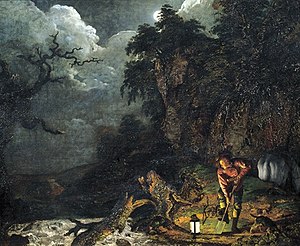art.wikisort.org - Painting
Earthstopper on the Banks of the Derwent is a painting by Joseph Wright of Derby originally completed in 1773. The scene shows a man digging at nighttime beside the River Derwent in Derbyshire.
| Earthstoppers | |
|---|---|
 | |
| Artist | Joseph Wright of Derby |
| Year | 1773 |
| Dimensions | 97 cm × 121 cm (38 in × 48 in) |
| Location | Derby Museum and Art Gallery, Derby |
Description
The painting shows a man blocking foxholes so that a subsequent foxhunt could kill the fox without the animal having the opportunity to hide underground. This man was known as an Earthstopper.
Joseph Wright was known for his studies under unusual lighting and this can be seen here combined with landscape. Wright completed few notable paintings that included landscapes before he went on his tour of Italy where he created a large number including those that showed the eruption of Vesuvias. Benedict Nicolson, who was an authority on Joseph Wright believed this painting inspired lines of poetry[1] in a collection named after and in aid of the preservation of Needwood Forest. The lines were written by Francis Noel Clarke Mundy, who later commissioned six Wright portraits, including one of himself. These three quarter length portraits were of himself and five of his friends in the uniform of Mundy's own private hunt. Mundy's lines read:
Whilst as the silver moonbeams rise,
Imagin'd temples strike my eyes
With tottering spire, and mouldering wall,
And high roof nodding to it's fall, -
His lanterns gleaming down the glade,
One, like a sexton with his spade,
Comes from their caverns to exclude
The midnight prowlers from the wood...[2]
It is apt that Wright who had based his own paintings like Miravan on literature should, in turn, inspire poetry in the group that included Erasmus Darwin and Anna Seward.
History
The painting was exhibited in 1773. It was bought by Philip Yorke who became a fellow of the Royal Society and was the 2nd Earl of Hardwicke. The painting remained in the Earl's family until it was sold by the fifth Earl[3] who was nicknamed "Champagne Charlie".[4] Coincidentally Charles Yorke (the 5th Earl) was known for his spendthrift ways and Disraeli appointed him, at the request of the Prince of Wales, to the title of Master of the Buckhounds[5] where he was his majesty's representative at Ascot. The painting was eventually bought by Benedict Nicolson (Wright's biographer)[3] who sold it via the Artfund into the collection of Derby Museum and Art Gallery.[6]
References
- Nicolson, Benedict (1968). Joseph Wright of Derby:Painter of Light p.97. Taylor & Francis. ISBN 9780710062840.
- Mundy, Francis Noel Clarke (1776). Needwood Forest p.19. John Jackson. p. 52.
- "An Earth Stopper on the Banks of the Derwent". artfund.org. Retrieved 30 May 2011.
- "Charles Yorke". Oxford Dictionary of National Biography. Retrieved 30 May 2011.
- F. M. L. Thompson, ‘Yorke, Charles Philip , fifth earl of Hardwicke (1836–1897)’, Oxford Dictionary of National Biography, Oxford University Press, 2004 accessed 30 May 2011
- "The Earthstopper". Treasures of Derby. derby.gov.uk. Archived from the original on 4 May 2009. Retrieved 29 May 2011.
На других языках
- [en] The Earthstopper
[fr] The Earthstopper
Earthstopper on the Banks of the Derwent (« Boucheur de terrier » sur les berges de la Derwent), ou simplement The Earthstopper, est un tableau de Joseph Wright of Derby qui l'acheva en 1773. La scène montre un homme en train de bêcher, de nuit, au bord de la Derwent, une rivière du Derbyshire.[it] Earthstopper sulle rive del Derwent
Earthstopper sulle rive del Derwent è un dipinto di Joseph Wright of Derby completato nel 1773.[ru] Человек, закапывающий норы
«Человек, закапывающий норы» (англ. Earthstopper on the Banks of the Derwent) — картина английского художника Джозефа Райта, завершённая в 1773 году. На картине изображён человек в красной куртке, ночью при свете луны и фонаря закапывающий лисьи норы на берегу реки Дервент в Дербишире. Норы закапываются для того, чтобы в дальнейшем охотник на лис мог убить зверя, не имеющего возможности спрятаться под землёй. Скорее всего, этот закапыватель и есть охотник; рядом с ним изображены его собака и лошадь. Снизу слева картина подписана надписью «J Wright P/1773». Вероятно, изображённая местность — Чёрч Рокс (Church Rocks), на юге Матлока[1].Другой контент может иметь иную лицензию. Перед использованием материалов сайта WikiSort.org внимательно изучите правила лицензирования конкретных элементов наполнения сайта.
WikiSort.org - проект по пересортировке и дополнению контента Википедии